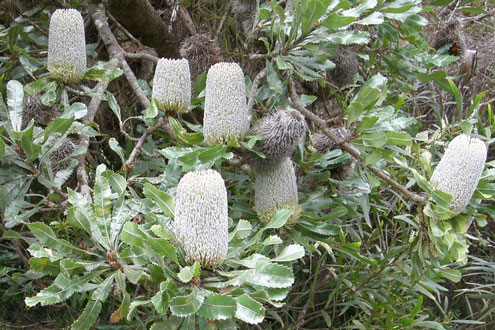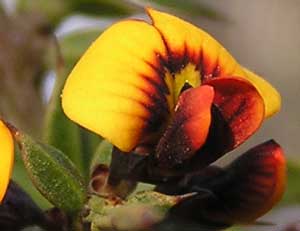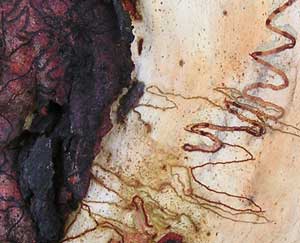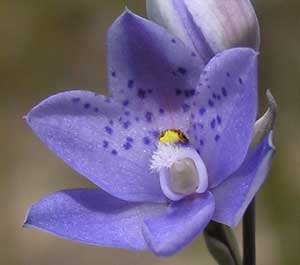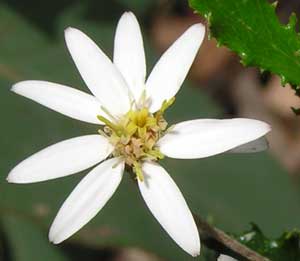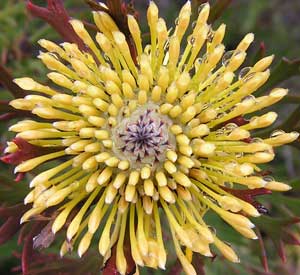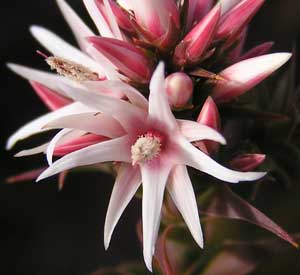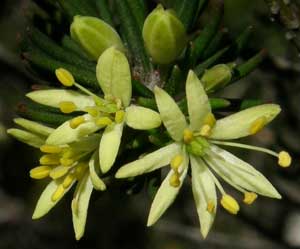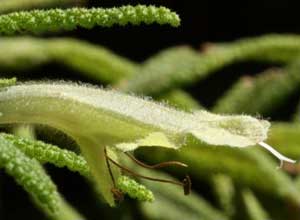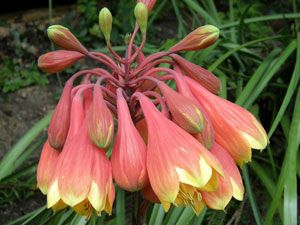There's 2,362 species* of native plants in the GBMWHA across 150 families and 619 genera.
[* - species in this case includes subspecies and varieties.]
Here's the list of the GBMWHA native flora species.
Showcased on this webpage are some of the species and their families - a family album.
12 families, between them, contain over 61% of the species; 33 families have only 1 species in the GBMWHA.
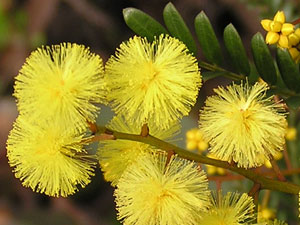 Sunshine Wattle (Acacia terminalis subsp. Bright yellow flower
Sunshine Wattle (Acacia terminalis subsp. Bright yellow flower(M.Tindale NSW248078))
Photo: Alan Page
- Fabaceae * (252) - pea flowers, acacias
- Myrtaceae (199) - eucalypts, tea-trees
- Poaceae (168) - grasses
- Orchidaceae (165) - orchids
- Asteraceae (161) - daisies
- Proteaceae (114) - banksias, grevilleas
- Cyperaceae (113) - sedges, rushes
- Ericaceae (75) - heaths
- Rutaceae (69) - boronias, zierias
- Lamiaceae (52) - mint-bushes
- Asphodelaceae (37) - flax-lilies, grass trees
- Rhamnaceae (37) - pomaderris
The endangered species are -
- Acacia bynoeana (Bynoe's Wattle)
- Acacia gordonii
- Acacia pendula (Weeping Myall)
- Pultenaea sp. Genowlan Point (NSW 417813)*
- Pultenaea sp. Olinda (R.Coveny 6616)
- Pultenaea villifera var. villifera**.
* critically endangered.
** endangered population in the Blue Mountains LGA.
- 139 - subfamily Faboideae (pea flowers)
- 108 - subfamily Mimosoideae (acacias)
- 5 - subfamily Caesalpinioideae (senna).
With nearly 20,000 species worldwide, it is the third largest flora family. It could be called the legume, pea and bean family.
While all animals and plants classed as threatened species under the Act are protected, several non-threatened species are also protected. An example of this is the Waratah (Telopea speciosissima). Protected species are not to be disturbed.
The endangered species are -
- Baeckea kandos
- Callistemon megalongensis (Megalong Valley Bottlebrush)*
- Eucalyptus macarthurii (Camden Woollybutt)
- Eucalyptus sp. Howes Swamp Creek (M.Doherty 26)
- Rhodamnia rubescens (Scrub Turpentine)*
- Syzygium paniculatum (Magenta Lilly Pilly).
* critically endangered. The Scrub Turpentine was gazetted as critically endangered in 2019.
The 1998 World Heritage Nomination lists 90 Eucalypt taxa. This combines Eucalyptus, Angophora and Corymbia species.
My 2021 study shows 99 species - Eucalyptus (89), Angophora (6) and Corymbia (4). While my new list of GBMWHA Flora has the same number of Angophora and Corymbia species, it has 11 more Eucalyptus species. This difference can be mainly explained by the supplementary list in my 2021 study of 11 possible inclusions.
Commercial products from the myrtaceae family include essential oils (eucalyptus and tea-tree), cloves, guava and allspice.
The vulnerable species is Ancistrachne maidenii.
One couldn't help but notice the profusion of native grasses appearing after the Black Summer Bushfires. These grasses helped protect the exposed soils and allowed the seeds from other native flora to germinate and grow. Mother Nature's first responders perhaps.
The Poaceae family includes wheat, corn, rice and bamboo.
There are 4 species that are vulnerable and 3 that are endangered.
The endangered species are -
- Diuris aequalis (Buttercup Doubletail)
- Prasophyllum fuscum (Slaty Leek Orchid)*
- Pterostylis saxicola (Sydney Plains Greenhood).
* critically endangered.
At 28,000 species, Orchidaceae, with Asteraceae, is one of the two largest families of flowering plants in the world.
The vanilla bean comes from the Vanilla planifolia orchid.
The vulnerable species are -
- Olearia cordata
- Ozothamnus tesselatus.
The endangered species is - Senecio linearifolius var. dangarensis.
It is noted that it is "restricted to a single known population in the Goulburn River National Park" - which is not in the GBMWHA.
However, this is in close proximity to the Wollemi National Park, and as it is an endangered species it has been retained here to highlight it.
In my 2016 GBMWHA native flora analysis, it was mentioned that Rhaponticum australe (Austral Cornflower or Native Thistle) was an endangered species. It was reclassified in 2021 to being extinct in NSW.
At 32,000 known species, Asteraceae, with orchidaceae, is one of the two largest families of flowering plants in the world.
Plants include lettuces and artichokes, chrysanthemums and dahlias, and the Calendula and Echinacea genera.
The endangered species are -
- Grevillea obtusiflora subsp. fecunda (Grey Grevillea)
- Hakea dohertyi (Kowmung Hakea)
- Persoonia glaucescens (Mittagong Geebung)
- Persoonia hirsuta subsp. evoluta (Hairy Geebung)
- Persoonia hirsuta subsp. hirsuta
- Persoonia oxycoccoides.
All members of the Isopogon (drumsticks), Persoonia (geebungs) and Petrophile (conesticks) genera that are native to NSW are protected.
The Waratah (Telopea speciosissima) is the floral emblem of NSW.
The vulnerable and endangered species are -
- Carex klaphakei (Klaphake's Sedge) - endangered
- Lepidosperma evansianum (Evans Sedge) - vulnerable.
All species of the Causis genus native to NSW are protected - see image shown here.
Members of the Cyperaceae family include the water chestnut and papyrus.
The vulnerable and endangered species are -
- Epacris hamiltonii - endangered
- Leucopogon fletcheri subsp. fletcheri - endangered
- Epacris purpurascens var. purpurascens - vulnerable
- Epacris sparsa (Sparse Heath) - vulnerable
- Leucopogon exolasius (Woronora Beard-heath) - vulnerable.
Members of the Ericaceae family include cranberries, blueberries, rhododendrons and azaleas.
The endangered species are -
- Asterolasia buxifolia
- Leionema lachnaeoides
- Zieria covenyi (Coveny's Zieria)
- Zieria involucrata.
All members of the Boronia and Philotheca genera that are native to NSW are protected.
Members of the Rutaceae family include oranges, lemons and limes.
The vulnerable species are -
- Prostanthera cineolifera (Singleton Mint Bush)
- Prostanthera cryptandroides (Wollemi Mint-bush)
- Prostanthera densa
- Prostanthera discolor
- Prostanthera stricta (Mount Vincent Mint-bush)
Members of the Lamiaceae family include basil, mint, rosemary, sage, oregano, thyme and lavender, and the teak tree.
The endangered species is Caesia parviflora var. minor (Small Pale Grass-lily).
The Asphodelaceae family now includes the Aloeaceae, Phormiaceae, Dianellaceae, Hemerocallidaceae and Xanthorrhoeaceae families.
Members of the Asphodelaceae family include Aloe vera and grass trees (Xanthorrhoea sp.) - the latter being endemic to Australia and all its species are protected.
The endangered species are -
- Pomaderris brunnea (Brown Pomaderris)
- Pomaderris cotoneaster (Cotoneaster Pomaderris)
- Pomaderris queenslandica (Scant Pomaderris)
- Pomaderris sericea (Silky Pomaderris).
27 of the 37 species recorded as being in the GBMWHA belong to the Pomaderris genus. [I find it hard to identify the actual species.]
The endangered species are -
- Cynanchum elegans (White-flowered Wax Plant)
- Trachymene scapigera (Mountain Trachymene)
- Wollemia nobilis (Wollemi Pine)*
- Allocasuarina glareicola
- Hibbertia procumbens (Spreading Guinea Flower)
- Lastreopsis hispida (Bristly Shield Fern)
- Monotaxis macrophylla (Large-leafed Monotaxis)
- Gyrostemon thesioides
- Androcalva rosea
- Commersonia prostrata (Dwarf Kerrawang)
- Seringia denticulata
- Euphrasia scabra (Rough Eyebright)
- Pherosphaera fitzgeraldii (Dwarf Mountain Pine)
- Grammitis stenophylla (Narrow-leaf Finger Fern)
- Solanum armourense
* critically endangered.

